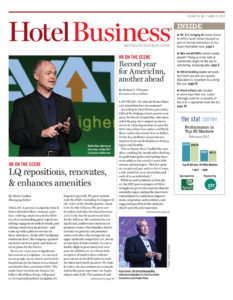NATIONAL REPORT—With supply expected to accelerate, a closer look as to how supply growth is assessed within REITs may be warranted—especially if some are concerned about investors underestimating or overestimating REIT portfolios in 2017.
“We anticipate that supply growth will continue to increase in 2017,” said Justin Knight, president and CEO of Apple Hospitality REIT Inc. “While much of the growth will continue to be concentrated around major markets, we have begun to see new-construction starts in some of our secondary markets, as well.”
Published by Canaccord Genuity Group Inc., a February 2017 report, which brings into question the way investors have been estimating supply growth, forecasts supply in the U.S. to increase by 2.2% in 2017 and 2.1% in 2018. The analysts also expect supply growth to peak in early 2017 at 2.5% before beginning to moderate.
Further, the researchers argued the need to re-evaluate the way investors estimate supply growth. “While most investors are aware supply growth is accelerating across the U.S., Wall Street’s focus on chainscales—and to a lesser extent, MSA-level data—has caused investors to underestimate supply growth for some companies and overestimate it for others,” the study, which analyzed 13 REITs, reported.
“First of all, the new Hilton Garden Inn in Tuscaloosa, AL, is not competitive with the Courtyard in Wichita, KS, but they are the same chainscale,” said Ryan Meliker, analyst at Canaccord. “Chainscales are relevant in understanding the types of properties developers are building and how the brand systems are growing—it offers no insight into the impact of existing hotels. The same argument could be made for the Marriott being built at JFK airport versus the Marriott in Times Square. Same market and chainscale, but not competitive with one another.”
Their solution? Assessing submarkets—a more granular approach. “We believe investor focus on chainscale-weighted supply growth (which is the easier data to get) is misplaced and depicts an inaccurate view of supply growth across portfolios, especially when compared to our submarket-level analysis,” the analysts contended. In their report, the analysts evaluate supply growth by submarket and by chainscale within each submarket; this, according to them, provides a more accurate outlook. Industry leaders, those heading REITs in the industry—including a few analyzed in the report—agree.
“Industry numbers, even when provided at a market level, are still broad indicators and do not always accurately reflect market dynamics impacting specific properties,” Knight said, responding to a question on where submarkets fit into the equation. “Relative proximity to demand generators, amenities and comparable quality all factor into the equation as well, but are more difficult to capture in industry summary statistics.”
Others believe the breakdown of supply growth data into submarkets is vital to understanding supply growth impacting existing hotels in the country. “Misunderstanding supply growth estimates can lead to invalid RevPAR growth expectations,” said Ian McAuley, president of American Hotel Income Properties REIT LP. “Supply growth in the specific MSAs requires further breakdown into the various submarkets to understand the impact of new supply. Similarly, a chainscale segment supply growth forecast can also be misleading to investors if not broken down into meaningful submarkets.”
Submarkets are of the utmost importance when examining supply, said Rob Hays, chief strategy officer at Ashford Inc. An asset being built across the street is more important than one going up across town. “When hotel owners are trying to determine the impact of supply, they need to look at the new supply that is directly competitive with their hotel assets, which is typically defined by the submarket,” he said.
Oftentimes, it’s difficult to figure out which new-builds will be financed and which ones will not; this can lead to investors underestimating and overestimating supply growth. “While developers announce their new hotel projects early in the process, the reality is that a large percentage of the announced new-builds will never get financing and, as a result, never get built,” Hays said. “This uncertainty around the financing markets makes it difficult to forecast the next 12 months around what the actually new supply will be.”
“The impact of supply growth on a specific market also depends largely on demand growth for the same market,” Knight said. “Separating the two provides only a partial view of market dynamics. In addition, consumers are not as easily separated into categories as we sometimes assume and, as a result, focusing on supply growth in a single segment can lead to false conclusions related to potential impact.”
Supply risks are centered around supply not being fully absorbed in a short amount of time. Occupancies can fall if demand doesn’t match supply. “Even when demand is there, new hotels might undercut on price to build a cash flow base to start paying debt service immediately,” Meliker said. “This can cause pricing across the entire submarket to feel pressure limiting RevPAR and RevPAR growth.”
With supply having a potential impact on RevPAR growth, it’s essential to understand the supply risks. The examination of submarkets takes a deeper look into the topic. “What we find is not all REITs have the same near-term supply risks and that is likely to show up in RevPAR growth this year and next year,” Meliker said. “The market doesn’t get this granular on supply, so the analysis is very value-add and highly relevant in the current period of the construction cycle. We think it helps investors differentiate between many REITs that have similar strategies and market exposures.”
How should investors value REITs? A mixed approach is needed; however, Canaccord’s analysts prefer a “blending of net asset value (based on the value of properties owned using a cap rate on forward-looking NOI); EVI/EBITDA multiples (on forward-year expectations); P/FFO multiples (on forward-year multiples); and a DCF analysis going out 10 years and assuming a recession at some point,” Meliker said. HB

